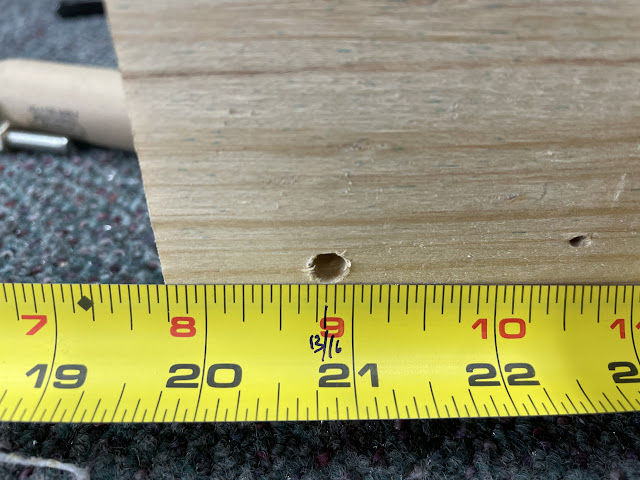The first step in the Canopy section, and indeed, the first step of the Finishing Kit, was to install the aft window. I was late July when i goto to this step, and it was still very cold outside. Van's has a document called Acrylic Canopy & Lexan Window hints which is very clear that i should not work on the canopy parts unless the shop temperature was over 15c, and they recomment 24-27c. So i skipped the first couple of pages, and moved to the canopy latch parts.
Canopy Latch Parts
The canoopy latch parts will be installed to allow the actuation of the canopy locking pins. There is a powercoated bar across the width of the cabin so the left and right pins work at the same time, so i elected to paint all these parts a satin white, to match the powercoating.
I also made up the pushrod which goes between the canopy latch handle and the canopy actuation mechanism - to get the distance and oriantation correct, i drilled some holes in some scrap timber, with the holes are the correct distance.
Canopy Parts Preperation / Countersinking Canopy Rail Bases
At the start of the canopy section, Van's gives this VERY ominous warning:
I didn't like the sounds of having my heart rended, so i made sure to follow the plans exactly...... EXCEPT!
On Page 38-09, we begin to rivet the canopy assembly together. You start by riveting the hinge assemblies to the forward and aft canopy frames. You then rivet a single outboard hole between the canopy frames and the canopy rail bases. The rivet is an AD4 flush rivet - however, the canopy rail bases have not been countersunk at this stage. They are not countersunk until the canopy skin is riveted on, on page 38-16. (The diagram showing the countersinks is on Page 38-17).
In addition, on 38-10, you dimple the end flanges, and cleco on the cnaopy frame close out skin. However, the canopy rail bases also have not been countersunk at this time to accept these dimples.
.png) |
| This single outboard hole cannot be flush riveted, as the canopy rail bases have not been countersunk yet. |
 |
| It is not possible to set this rivet on Page 38-09, Step 5, as the canopy rail bases have not been countersunk as yet. |
 |
| Similarly, if you dimple the canopy frame close out end flanges as per 38-10 Step 1, you are not able to cleco these onto the canopy rail bases as these have not been countersunk until Page 38-16. |
So what to do?
Obviously, DESPITE THE OMINIOUS WARNING, i need to countersink the canopy rail bases. I decided to go ahead and countersink these prior to seperating them. I was very careful not to countersink too deep and enlarge the holes - as these holes are used to cleco on the canopy alignment bars.
 |
| This describes which holes are countersunk for what. |
 |
| The completed countersunk holes - i made sure with calipers that none of the holes had become oversized. |
 |
| The canopy rail bases were not flat, and needed a bit of fluting. |
Since i was going to prime the canopy skin, i also went ahead and chamfered the skin edges as per Page 38-15 Step 6.
 |
| The initial canopy parts read for priming. |
 |
| Etched and Cleaned and readuy to go. |
 |
| This ironing board "workbench" has seen some projects over the years! |
 |
| The driveway cleaning, scrubbing and etching station. |
Voice from the Future:
My canopy frame turned out well and fits the fuselage. However, i
think i would do this differently next time. At this stage, i would only
countersink the holes required to set the single outboard rivets between the
canopy frames and the canopy rail bases (on Page 38-09). These are not used for
canopy alignment. I would therefore not dimple the canopy close out skin
flanges on Page 38-10 Step 1, until later on, after the canopy rail bases are
countersunk (on Page 38-16). This means that when you attach the alignment bars, the holes have not been countersunk, and are certain to be of the correct dimension. While i checked that the countersunk holes were not oversized, the cleco's at the end of my canopy riveting session were pretty loose in the holes, so i think the clecos themselves may have enlarged the holes a little bit. This could have affect alignment, but my canopy thankfully fits well.
 |
These 4 holes are the ones where a single outboard flush
rivet is used to connect the canopy frames to the canopy rail bases on Page
38-09. These are the only ones i would countersink, if i were doing it again.
This ensures the alignment holes are not countersunk for the rest of the canopy
build. I would not dimple the canopy close out skin on Page 38-10, as the
mating holes are not countersunk as yet. |
Next up we will start to rivet the canopy frame parts together.
.png)























No comments:
Post a Comment